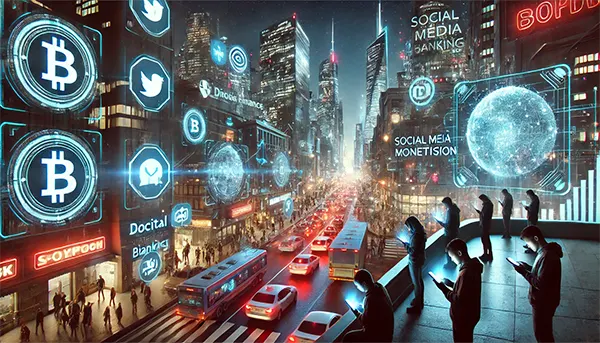
How Social Media Are Becoming Digital Banks: Content Monetisation in 2025
In 2025, social media platforms have evolved beyond their traditional role as communication and entertainment hubs. With integrated financial tools, they now serve as digital banks, offering creators multiple ways to monetise their content. The rise of in-app payment systems and blockchain technology has further transformed the financial landscape of these platforms.
New Earning Models for Creators via Built-in Payment Systems
Social media platforms are no longer just places for sharing content—they have become full-fledged economic ecosystems. TikTok, X (formerly Twitter), and Instagram have implemented built-in payment systems that allow creators to earn directly from their audience. These systems include tipping, subscription-based content, and revenue-sharing on exclusive posts.
In TikTok, the Creator Fund has evolved into a more dynamic monetisation model where users can receive micropayments based on engagement rather than simple views. This change provides more direct incentives for content quality. X has introduced a streamlined payment system, enabling content creators to receive instant payments via cryptocurrencies and fiat currencies alike.
Instagram has expanded its paid subscriptions, allowing influencers to offer exclusive content, live Q&A sessions, and direct messaging benefits to subscribers. This model provides stable income streams, making social media a viable full-time profession for many.
Comparison of Social Media Earnings in 2024-2025
The financial potential for content creators has significantly changed between 2024 and 2025. While ad revenue remains a key source of income, direct audience payments have surpassed traditional advertising models for many creators.
In 2024, YouTube remained dominant in revenue generation, thanks to its partnership programme. However, by 2025, TikTok and X have closed the gap with more creator-friendly policies and higher revenue shares. Monetisation models based on direct support, such as donations and membership subscriptions, have outpaced traditional ad-based models.
Additionally, platforms like Patreon and OnlyFans have seen a decline in popularity as social media giants integrate similar subscription-based monetisation tools. This shift consolidates the earning potential within major platforms, eliminating the need for external services.
The Role of Cryptocurrencies in Social Media
Cryptocurrencies have played an increasingly significant role in social media transactions. With the rise of Web3 integration, platforms now support decentralised payments, allowing creators to accept tips and donations in Bitcoin, Ethereum, and stablecoins.
X has become a pioneer in blockchain-based payments, allowing instant transactions with minimal fees. This has enabled international creators to bypass traditional banking systems and receive earnings directly, regardless of geographical location. Instagram has also experimented with NFT-based monetisation, allowing artists to sell digital assets directly to their followers.
Additionally, TikTok has introduced a token-based reward system, allowing fans to support their favourite creators through a blockchain-secured ecosystem. These tokens can be exchanged for fiat currency or used within the platform for premium features.
How Cryptocurrencies Are Used for Donations and Payments
Beyond direct monetisation, cryptocurrencies have become a preferred method for donations and service payments within social media platforms. Decentralised finance (DeFi) tools allow users to crowdfund projects, tip creators, and even pay for premium content without intermediaries.
For example, X has launched a peer-to-peer crypto payment system that allows creators to receive donations in various digital assets instantly. Similarly, TikTok’s digital wallet now supports cryptocurrency transactions, making international payments seamless.
By removing banking restrictions, cryptocurrencies have opened new opportunities for creators, particularly in regions with limited access to traditional financial services. As a result, social media platforms have effectively become digital banks, providing financial independence to millions of users worldwide.

The Future of Social Media as Financial Platforms
As social media companies continue to integrate financial services, their role as digital banks is expected to expand further. In 2025, platforms are experimenting with decentralised autonomous organisations (DAOs) that allow communities to collectively fund and manage projects.
The introduction of AI-powered financial tools has also enhanced security, making in-app transactions safer and more efficient. Social media platforms are now partnering with fintech companies to provide instant lending and investment opportunities to users, transforming how individuals manage their finances.
Regulatory bodies are beginning to recognise social media platforms as financial institutions, leading to new regulations that protect users from fraud and financial risks. While this could impose stricter compliance measures, it also legitimises the role of social media in the global economy.
What to Expect Next in Social Media Monetisation
Looking ahead, we can expect even greater financial integration within social media platforms. Features such as AI-driven financial advisory, decentralised lending, and cross-platform investment opportunities are likely to become standard.
Creators will have access to a more diverse set of income streams, including tokenised rewards, blockchain royalties, and smart contracts that automate revenue distribution. As the gap between social media and traditional banking continues to shrink, users will rely on these platforms not just for content but for financial transactions as well.
By 2025, social media platforms will no longer be just a tool for communication—they will be fully functioning digital economies, reshaping the way people earn, spend, and invest.
